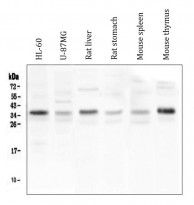ARG41573
anti-CD154 / CD40L antibody
anti-CD154 / CD40L antibody for Western blot and Human,Mouse,Rat
Overview
| Product Description | Rabbit Polyclonal antibody recognizes CD154 / CD40L |
|---|---|
| Tested Reactivity | Hu, Ms, Rat |
| Tested Application | WB |
| Host | Rabbit |
| Clonality | Polyclonal |
| Isotype | IgG |
| Target Name | CD154 / CD40L |
| Antigen Species | Human |
| Immunogen | Synthetic peptide corresponding to a sequence of Human CD154 / CD40L. (KEETKKENSFEMQKGDQNPQIAAHVISEA) |
| Conjugation | Un-conjugated |
| Alternate Names | TNFSF5; IMD3; T-cell antigen Gp39; HIGM1; CD40-L; gp39; CD40 ligand; Tumor necrosis factor ligand superfamily member 5; CD40L; CD154; TRAP; CD antigen CD154; hCD40L; IGM; T-BAM; TNF-related activation protein |
Application Instructions
| Application Suggestion |
|
||||
|---|---|---|---|---|---|
| Application Note | * The dilutions indicate recommended starting dilutions and the optimal dilutions or concentrations should be determined by the scientist. | ||||
| Observed Size | ~ 36 kDa |
Properties
| Form | Liquid |
|---|---|
| Purification | Affinity purification with immunogen. |
| Buffer | 0.2% Na2HPO4, 0.9% NaCl, 0.05% Sodium azide and 4% Trehalose. |
| Preservative | 0.05% Sodium azide |
| Stabilizer | 4% Trehalose |
| Concentration | 0.5 mg/ml |
| Storage Instruction | For continuous use, store undiluted antibody at 2-8°C for up to a week. For long-term storage, aliquot and store at -20°C or below. Storage in frost free freezers is not recommended. Avoid repeated freeze/thaw cycles. Suggest spin the vial prior to opening. The antibody solution should be gently mixed before use. |
| Note | For laboratory research only, not for drug, diagnostic or other use. |
Bioinformation
| Database Links | |
|---|---|
| Gene Symbol | CD40LG |
| Gene Full Name | CD40 ligand |
| Background | The protein encoded by this gene is expressed on the surface of T cells. It regulates B cell function by engaging CD40 on the B cell surface. A defect in this gene results in an inability to undergo immunoglobulin class switch and is associated with hyper-IgM syndrome. [provided by RefSeq, Jul 2008] |
| Function | Mediates B-cell proliferation in the absence of co-stimulus as well as IgE production in the presence of IL-4. Involved in immunoglobulin class switching. Release of soluble CD40L from platelets is partially regulated by GP IIb/IIIa, actin polymerization, and an matrix metalloproteinases (MMP) inhibitor-sensitive pathway. [UniProt] |
| Cellular Localization | Cell membrane; Single-pass type II membrane protein. Cell surface. CD40 ligand, soluble form: Secreted. [UniProt] |
| Calculated MW | 29 kDa |
| PTM | The soluble form derives from the membrane form by proteolytic processing. N-linked glycan is a mixture of high mannose and complex type. Glycan structure does not influence binding affinity to CD40. Not O-glycosylated. [UniProt] |
Images (1) Click the Picture to Zoom In






